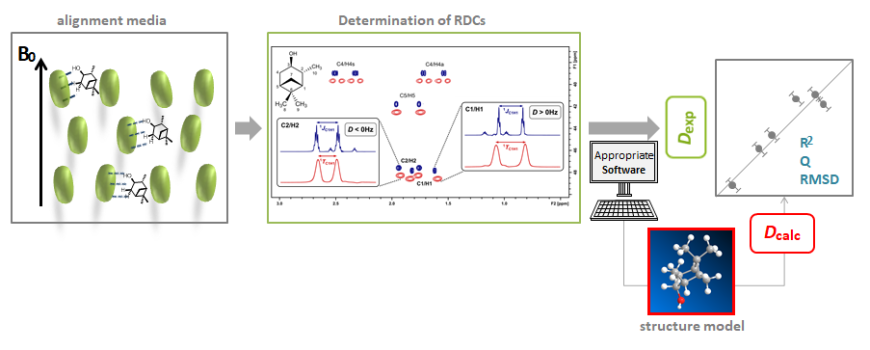In our group, we are working on a broad range of applications of nuclear magnetic resonance (NMR) spectroscopy. A large portion of our research interest focuses on the (three-dimensional) structure determination of complex organic compounds (constitution, configuration as well as conformation). This also includes investigations of reaction mechanisms, where chemical kinetics and dynamic processes are monitored by NMR spectroscopy. For this purpose, the development of novel measurement and analysis methods is of prime importance. The NMR spectra enable us to measure complementary NMR parameters like nuclear Overhauser enhancements (NOEs), scalar couplings (J-couplings) and residual dipolar couplings (RDCs) from which a comprehensive picture of a (complex) structure is derived. Increasing complexity of the system investigated requires further development of the methods to overcome limitations due to conformational flexibility, dynamics and complex stereochemistry to finally arrive at an unambiguous solution of the structure determination problem. For this purpose, we employ a variety of techniques.
Conventional high-resolution NMR experiments use samples with isotropic solutions, such that NMR interactions like chemical shifts, scalar couplings and NOEs become observable. Chemical shifts report on the chemical environment of the individual nuclei. Scalar couplings are related to the enclosed dihedral angle of the coupling nuclei and are classically determined from the line splitting of a signal. In complicated cases of overlapping multiplets we employ multidimensional methods like the (TSE-)PSYCHEDELIC experiment. To complement these parameters, we determine the distances between interacting nuclei with extensive quantitative NOE or ROE (rotating frame NOE) experiments. Modern EASY-ROESY experiments nowadays allow for mostly artefact-free, quantitative spectra to be recorded with moderate experimental effort. Particularly in the case of overlapping signals, so-called pure shift spectra can be very helpful. This is not only the case for the measurement of NMR observables in isotropic solutions, but also for the measurement of residual dipolar couplings (RDCs).
Anisotropic NMR parameters like residual chemical shift anisotropies (RCSAs), residual quadrupolar couplings (RQCs) and residual dipolar couplings (RDCs) give structure information complementary to the classical isotropic NMR observables, even though only being observable in an anisotropic environment. For the experimental measurement of RDCs, a compound of interest is therefore aligned with respect to the external magnetic field in a lyotropic liquid crystalline phase or more generally any “alignment medium”, and the line splittings observed are compared with those from corresponding isotropic reference experiments. For this purpose, we develop novel polymeric alignment media as well as optimized methods to measure and analyze RDC data. The interpretation of RDCs in the context of structure determination usually requires computational support. We have developed an analysis software package (RDC@hotFCHT) which uses a mathematical fitting procedure to correlate the experimental data with different structure models, determine the relative arrangement of molecular fragments or investigate the conformational equilibrium of flexible compounds.
It is not always possible to define an explicit structure model for this kind of RDC analysis. We develop a new model-free approach (TITANIA) to directly extract structure and dynamics parameters from RDC data from multiple alignment media without a previously explicitly defined structure model. This, however, requires the collection of an extensive sets of RDC data in sufficiently different alignment media, ideally including long-range RDCs over multiple bonds.
We also develop concepts for combined methods like in situ irradiation NMR spectroscopy, coupled observation of NMR and UV-vis spectra in the same experimental setup and reaction monitoring with rapid injection. These are used to monitor transition metal-catalyzed reactions and their intermediates as well as photochemical processes. As a non-destructive and quantitative method that can monitor reactions on a minute to hour time scale, NMR spectroscopy is particularly suited to determine chemical kinetics.










